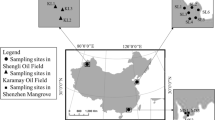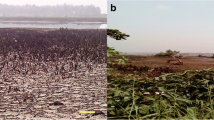Abstract
Polycyclic aromatic hydrocarbons (PAHs) are one of the major pollutants in soils in oil exploring areas. Biodegradation is the major process for natural elimination of PAHs from contaminated soils. Functional genes can be used as biomarkers to assess the biodegradation potential of indigenous microbial populations. However, little is known about the distribution of PAH-degrading genes in the environment. The links between environmental parameters and the distribution of PAH metabolic genes remain essentially unclear. The present study investigated the abundance and diversity of naphthalene dioxygenase genes in the oil-contaminated soils in the Shengli Oil Field (China). Spatial variations in the density and diversity of naphthalene dioxygenase genes occurred in this area. Four different sequence genotypes were observed in the contaminated soils, with the predominance of novel PAH-degrading genes. Pearson’s correlation analysis illustrated that gene abundance had positive correlations with the levels of total organic carbon and aromatic hydrocarbons, while gene diversity showed a negative correlation with the level of polar aromatics. This work could provide some new insights toward the distribution of PAH metabolic genes and PAH biodegradation potential in oil-contaminated ecosystems.



Similar content being viewed by others
References
Badejo AC, Badejo AO, Shin KH, Chai YG (2013) A gene expression study of the activities of aromatic ring-cleavage dioxygenases in Mycobacterium gilvum PYR-GCK to changes in salinity and pH during pyrene degradation. PLoS One 8:e58066
Baldwin BR, Nakatsu CH, Nies L (2003) Detection and enumeration of aromatic oxygenase genes by multiplex and real-time PCR. Appl Environ Microbiol 69:3350–3358
Ball A, Truskewycz A (2013) Polyaromatic hydrocarbon exposure: an ecological impact ambiguity. Environ Sci Pollut Res 20:4311–4326
Bengtsson G, Torneman N, De Lipthay JR, Sorensen SJ (2013) Microbial diversity and PAH catabolic genes tracking spatial heterogeneity of PAH concentrations. Microb Ecol 65:91–100
Bordenave S, Goni-urriza M, Vilette C, Blanchard S, Caumette P, Duran R (2008) Diversity of ring-hydroxylating dioxygenases in pristine and oil contaminated microbial mats at genomic and transcriptomic levels. Environ Microbiol 10:3201–3211
Castro-Gutierrez VM, Rodriguez-Rodriguez CE, Vargas-Azofeifa I (2012) Hydrocarbon degrading microflora in a tropical fuel-contaminated aquifer: assessing the feasibility of PAH bioremediation. Int J Environ Res 6:345–352
Castro-Silva C, Ruiz-Valdiviezo VM, Valenzuela-Encinas C, Alcantara-Hernandez RJ, Navarro-Noya YE, Vazquez-Nunez E, Luna-Guido M, Marsch R, Dendooven L (2013) The bacterial community structure in an alkaline saline soil spiked with anthracene. Electron J Biotechnol 16:14 doi: 10.2225/vol16-issue5-fulltext-14
Cebron A, Louvel B, Faure P, France-Lanord C, Chen Y, Murrell JC, Leyval C (2011) Root exudates modify bacterial diversity of phenanthrene degraders in PAH-polluted soil but not phenanthrene degradation rates. Environ Microbiol 13:722–736
Chen SC, Hickey WJ (2011) Development of tools for genetic analysis of phenanthrene degradation and nanopod production by Delftia sp. Cs1-4. Front Microbiol 2:187
Chen CF, Chen CW, Dong CD, Kao CM (2013) Assessment of toxicity of polycyclic aromatic hydrocarbons in sediments of Kaohsiung Harbor, Taiwan. Sci Total Environ 463:1174–1181
da Silva AS, Jacques RJS, Andreazza R, Bento FM, Camargo FAD (2013) The effects of trace elements, cations, and environmental conditions on protocatechuate 3,4-dioxygenase activity. Sci Agric 70:68–73
DeBruyn JM, Chewning CS, Sayler GS (2007) Comparative quantitative prevalence of Mycobacteria and functionally abundant nidA, nahAc, and nagAc dioxygenase genes in coal tar contaminated sediments. Environ Sci Technol 41:5426–5432
Ferradji FZ, Mnif S, Badis A, Rebbani S, Fodil D, Eddouaouda K, Sayadi S (2014) Naphthalene and crude oil degradation by biosurfactant producing Streptomyces spp. isolated from Mitidja plain soil (North of Algeria). Int Biodeterior Biodegrad 86:300–308
Ferrero M, Llobet-Brossa E, Lalucat J, Garcia-Valdes E, Rossello-Mora R, Bosch R (2002) Coexistence of two distinct copies of naphthalene degradation genes in Pseudomonas strains isolated from the western Mediterranean region. Appl Environ Microbiol 68:957–962
Festa S, Coppotelli BM, Morelli IS (2013) Bacterial diversity and functional interactions between bacterial strains from a phenanthrene-degrading consortium obtained from a chronically contaminated-soil. Int Biodeterior Biodegrad 85: SI 42–51
Gomes NCM, Borges LR, Paranhos R, Pinto FN, Krogerrecklenfort E, Mendonca-Hagler LCS, Smalla K (2007) Diversity of ndo genes in mangrove sediments exposed to different sources of polycyclic aromatic hydrocarbon pollution. Appl Environ Microbiol 73:7392–7399
Haritash AK, Kaushik CP (2009) Biodegradation aspects of polycyclic aromatic hydrocarbons (PAHs): a review. J Hazard Mater 169:1–15
Isaac P, Sanchez LA, Bourguignon N, Cabral ME, Ferrero MA (2013) Indigenous PAH-degrading bacteria from oil-polluted sediments in Caleta Cordova, Patagonia Argentina. Int Biodeterior Biodegrad 82:207–214
Jeon CO, Park W, Padmanabhan P, DeRito C, Snape JR, Madsen EL (2003) Discovery of a bacterium, with distinctive dioxygenase, that is responsible for in situ biodegradation in contaminated sediment. Proc Natl Acad Sci U S A 100:13591–13596
Jimenez N, Vinas M, Guiu-Aragones C, Bayona JM, Albaiges J, Solanas AM (2011) Polyphasic approach for assessing changes in an autochthonous marine bacterial community in the presence of Prestige fuel oil and its biodegradation potential. Appl Microbiol Biotechnol 91:823–834
Jurelevicius D, AlvarezVM PR, Rosado AS, Seldin L (2012) Bacterial polycyclic aromatic hydrocarbon ring-hydroxylating dioxygenases (PAH-RHD) encoding genes in different soils from King George Bay, Antarctic Peninsula. Appl Soil Ecol 55:1–9
Kim JD, Shim SH, Lee CG (2005) Degradation of phenanthrene by bacterial strains isolated from soil in oil refinery fields in Korea. J Microbiol Biotechnol 15:337–345
Klankeo P, Nopcharoenkul W, Pinyakong O (2009) Two novel pyrene-degrading Diaphorobacter sp and Pseudoxanthomonas sp isolated from soil. Biosci Bioeng 108:488–495
Liang YT, Zhang X, Wang J, Li GH (2012) Spatial variations of hydrocarbon contamination and soil properties in oil exploring fields across China. J Hazard Mater 241:371–378
Lloyd-Jones G, Laurie AD, Hunter DWF, Fraser R (1999) Analysis of catabolic genes for naphthalene and phenanthrene degradation in contaminated New Zealand soils. FEMS Microbiol Ecol 29:69–79
Louati H, Ben Said O, Got P, Soltani A, Mahmoudi E, Cravo-Laureau C, Duran R, Aissa P, Pringault O (2013) Microbial community responses to bioremediation treatments for the mitigation of low-dose anthracene in marine coastal sediments of Bizerte lagoon (Tunisia). Environ Sci Pollut Res 20:300–310
Margesin R, Labbe D, Schinner F, Greer CW, Whyte LG (2003) Characterization of hydrocarbon-degrading microbial populations in contaminated and pristine alpine soils. Appl Environ Microbiol 69:3085–3092
Martin F, Malagnoux L, Violet F, Jakoncic J, Jouanneau Y (2013) Diversity and catalytic potential of PAH-specific ring-hydroxylating dioxygenases from a hydrocarbon-contaminated soil. Appl Microbiol Biotechnol 97:5125–5135
Ni B, Zhang Y, Chen DW, Wang BJ, Liu SJ (2013) Assimilation of aromatic compounds by Comamonas testosteroni: characterization and spreadability of protocatechuate 4,5-cleavage pathway in bacteria. Appl Microbiol Biotechnol 97:6031–6041
Olivera NL, Commendatore MG, Delgado O, Esteves JL (2003) Microbial characterization and hydrocarbon biodegradation potential of natural bilge waste microflora. J Ind Microbiol Biotechnol 30:542–548
Schloss PD, Handelsman J (2005) Introducing DOTUR, a computer program for defining operational taxonomic units and estimating species richness. Appl Environ Microbiol 71:1501–1506
Singh D, Ramanathan G (2013) Biomineralization of 3-nitrotoluene by Diaphorobacter species. Biodegradation 24:645–655
Sojinu OSS, Wang JZ, Sonibare OO, Zeng EY (2010) Polycyclic aromatic hydrocarbons in sediments and soils from oil exploration areas of the Niger Delta, Nigeria. J Hazard Mater 174:641–647
Sorokin DY, Janssen AJH, Muyzer G (2012) Biodegradation potential of halo(alkali)philic prokaryotes. Crit Rev Environ Sci Technol 42:811–856
Sun WM, Sun XX, Cupples AM (2014) Identification of Desulfosporosinus as toluene-assimilating microorganisms from a methanogenic consortium. Int Biodeterior Biodegrad 88:13–19
Sun WM, Sun XX, Cupples AM (2014) Presence, diversity and the enumeration of toluene degrading functional genes (bssA and bamA) across a range of redox conditions and inoculum sources. Biodegradation 25:189–203
Tam NFY, Guo CL, Yau WY, Wong YS (2002) Preliminary study on biodegradation of phenanthrene by bacteria isolated from mangrove sediments in Hong Kong. Mar Pollut Bull 45:SI 316–324
Tamura K, Dudley J, Nei M, Kumar S (2007) MEGA4, molecular evolutionary genetics analysis, MEGA software version 4.0. Mol Biol Evol 24:1596–1599
Tondervik A, Bruheim P, Berg L, Ellingsen TE, Kotlar HK, Valla S, Throne-Holst M (2012) Ralstonia sp U2 naphthalene dioxygenase and Comamonas sp JS765 nitrobenzene dioxygenase show differences in activity towards methylated naphthalenes. J Biosci Bioeng 113:173–178
Vivas A, Moreno B, del Val C, Macci C, Masciandaro G, Benitez E (2008) Metabolic and bacterial diversity in soils historically contaminated by heavy metals and hydrocarbons. J Environ Monit 10:1287–1296
Wan R, Wang Z, Xie SG (2014) Dynamics of communities of bacteria and ammonia-oxidizing microorganisms in response to simazine attenuation in agricultural soil. Sci Total Environ 472:502–508
Wang JX, Henkelmann B, Bi YH, Zhu KX, Pfister G, Hu W, Temoka C, Westrich B, Schramm KW (2013) Temporal variation and spatial distribution of PAH in water of Three Gorges Reservoir during the complete impoundment period. Environ Sci Pollut Res 20:7071–7079
Wu P, Wang YS, Sun FL, Wu ML, Peng YL (2014) Bacterial polycyclic aromatic hydrocarbon ring-hydroxylating dioxygenases in the sediments from the Pearl River estuary, China. Appl Microbiol Biotechnol 98:875–884
Zhang SY, Wang QF, Xie SG (2012) Molecular characterization of phenanthrene-degrading methanogenic communities in leachate-contaminated aquifer sediment. Int J Environ Sci Technol 9:705–712
Zhang SY, Wang QF, Xie SG (2012) Bacterial and archaeal community structures in phenanthrene amended aquifer sediment microcosms under oxic and anoxic conditions. Int J Environ Res 6:1077–1088
Zhang SY, Wang QF, Xie SG (2012) Stable isotope probing identifies anthracene degraders under methanogenic conditions. Biodegradation 23:221–230
Zhang ZY, Zhao X, Liang YT, Li GH, Zhou JZ (2013) Microbial functional genes reveal selection of microbial community by PAHs in polluted soils. Environ Chem Lett 11:11–17
Zhou HW, Guo CL, Wong YS, Tam NFY (2006) Genetic diversity of dioxygenase genes in polycyclic aromatic hydrocarbons-degrading bacteria isolated from mangrove sediments. FEMS Microbiol Lett 262:148–157
Zhou XD, Wang QF, Wang Z, Xie SG (2013) Nitrogen impacts on atrazine-degrading Arthrobacter strain and bacterial community structure in soil microcosms. Environ Sci Pollut Res 20:2484–2491
Acknowledgments
This work was financially supported by the Public Welfare Project of Ministry of Environmental Protection (201309034).
Author information
Authors and Affiliations
Corresponding authors
Additional information
Yuyin Yang and Jie Wang contributed equally to this study.
Electronic Supplementary Material
Below is the link to the electronic supplementary material.
Fig. S1
Rarefaction curves of OTUs in the different soil samples (DOCX 72 kb)
Rights and permissions
About this article
Cite this article
Yang, Y., Wang, J., Liao, J. et al. Distribution of Naphthalene Dioxygenase Genes in Crude Oil-Contaminated Soils. Microb Ecol 68, 785–793 (2014). https://doi.org/10.1007/s00248-014-0457-7
Received:
Accepted:
Published:
Issue Date:
DOI: https://doi.org/10.1007/s00248-014-0457-7




